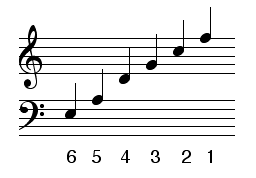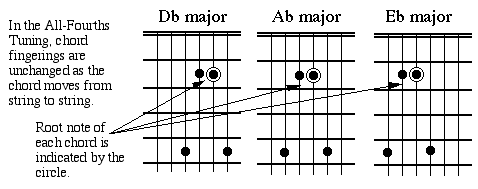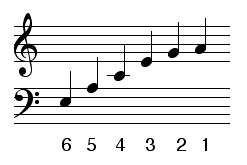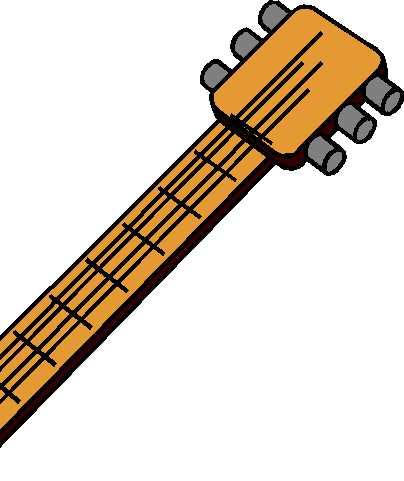
Tunings for 19 Tone Equal Tempered Guitar

|
|
by William A. Sethares
This is the article (more or less) as it first appeared in Experimental Musical Instruments, Vol. VI, No. 6, April 1991.
| There are two ways to acquire a 19 tone equal tempered (19-tet) guitar: refret your old strat, or mortgage your mother to buy a MIDI guitar controller and suitable sound module. In either case, it is an instrument for which no "how to" books are available. How to best tune the strings? How to play a major scale? How to play a minor seventh chord? Guitars tend to be chordal instruments. Yet a 19-tet beast is unhappy with standard chord fingerings and is soured by tried and true scale runs. This article reports some explorations with a 19-tet guitar and proposes three "alternate" tunings, along with scale and chord charts. Some general strategies emerge for finding useful tunings for the strings when confronted with a new temperment. |
Why 19?
From a just intonation point of view, 19 is a sensible equal temperment because it gives greater purity of major and minor thirds (and their inversions the major and minor sixths) than 12 tone equal temperament, yet it does not have an overwhelmingly large number of pitches per octave. Tim Perkins comments that 19-tet is "a usable one for harmonic music". Yet my first few minutes with a 19-tet fretboard were disorienting... where is the fifth? Where are these thirds that are so pure? I needed a tonal center (call me old fashioned). I needed a "chord chart" around which to focus my explorations. This article provides chord charts and other hints, as well as a brief discussion of the "music theory" of 19-tet.
| 19-tet divides the octave into 19 equal sounding parts, in the same way that the standard 12-tet tuning divides the octave into 12 equal sounding parts. |
Notation
In 19-tet, the octave is divided into 19 equal steps. Since an octave contains 1200 cents, each 19-tet step is 1200/19 cents, or about 63.16 cents, which is a little more than half a standard semitone. For a nice discussion of the 19-tet tuning (and many others as well), including a chart with all 19 tones specified in cents and in ratio intervals, consult Scott Wilkinson's Tuning In, or surf over to the microtonal synthesis web site.
Nineteen tone equal temperament is closely related to twelve tone equal temperament and provides a solid bridge from familiar tonalities into unfamiliar. One point of similarity is that standard musical notation can be easily extended to the 19-tet setting. John Chalmers article in Experimental Musical Instruments states that the following mapping of note names to scale pitches is "favored by many current 19-tonalists." In this figure, each ascending note sounds one nineteenth of an octave higher than the last - thus C# is not the same as Db, nor is D# the same as Eb.

Choosing a scale made up of the 19-tet pitches C,D,E,F,G,A,B,C provides a close approximation to the 12-tet major scale. Thus, much of standard music theory can be appropriated directly to describe 19-tet events.
It is easy to define 19-tet chords, and more importantly, these chords function musically much like their 12-tet counterparts. This makes the creation of a "chord chart" for 19-tet fretboards relatively straightforward. For example, a major chord in root position consists of a root, the tone 6 steps higher, and then the note 5 steps higher. Thus C-E-G and D#-Gb-A# (but not D#-F#-A#) are major chords. Similarly, minor chords are defined as a root followed by the tone 5 steps higher and then the note 6 steps up. Thus C-Eb-G and D#-F#-A# are minor chords. Analogously, major and minor sevenths, dominant sevenths, major and minor sixths, ninth and diminished chords can all be defined. These provide a solid starting point from which to conduct explorations of the 19-tet fretboard.
New Tunings
Guitar players instinctively tune to EBGDAE, as if these letters form a sacred mantra. Why is this guitar tuning standard? Where did this strange combination of a major 3rd and four perfect 4ths come from? There is a bit of history (view the guitar as a descendant of the lute), a bit of technology (strings which are too high and thin tend to break, those which are too low tend to be too soft), and a bit of chance. Even supposing that EBGDAE is optimal for a 12-tet guitar (and this is a big supposition), there is no obvious reason why it should also make a good tuning for a 19-tet beast. We are unconstrained by history (since there is no history of 19-tet tunings), and the technological constraints are different... with MIDI guitar controllers, tunings need not be confined by the mechanics of string widths and neck tensions. In fact, EBGDAE makes a relatively poor 19-tet fretboard tuning. There is only one way to finger major chords, and there is no way to comfortably finger minor chords. We can do better.
In the accompanying figures, you'll find my three favorite "alternate" tunings for use with 19-tet guitar. The All Fourths tuning, first used in my composition Incidences and Coincidences, is a regular tuning that keeps much of the feel of EBGDAE while providing easier fingerings for most chords. The Accidental tuning was born along with the song David, Please Stop Talking and is the sort of tuning one is likely to stumble on serendipitously (I did). Finally, in the Open Minor Seventh tuning, the six strings are tuned to a minor seventh chord. This worked particularly well in the compositions Truth on a Bus. and Sympathetic Metaphor.
In these figures, you will find a definition of the tuning in the 19-tet notation outlined above, a diagram of the guitar fretboard with the note names displayed along with a highlighted major scale, and a selection of interesting chord forms. All chords are "bar" chords in the sense that they are moveable up and down the fretboard and the root of the chord is circled. Of course, placing the lowest indicated tone at the nut gives an open chord form. For those whose fingers are less nimble, the open forms are generally easier to finger.
|
|
|
 |
|
|
The 19-tet All Fourths Tuning |
|
|
|
and fretboard |
|
|
|
|
|
|
|
|
|

Guitarists are used to hearing a perfect fourth when moving fingers from string to string at the same fret. The All Fourths tuning maintains this element of familiarity. In addition, the tuning is regular, that is, the strings are equally spaced in pitch. This means that any finger pattern can be moved up and down on the neck (like a normal bar chord) and also sideways across the neck. For instance, the "pattern" of the four high strings of the Db major chord below can be shifted one string down to form an Ab major chord, and can be shifted down yet another string to form an Eb major.

Similarly, any of the All Fourths chord forms can be moved from string to string, as well as from fret to fret. Regular tunings greatly simplify the learning of chords, since each finger pattern is useable for several different chords. Of course, there are many more chords in the all fourths tuning.
Retune a synthesizer sound module to 19-tet. Plug in a MIDI guitar controller, leaving it in its standard tuning. You have discovered the Accidental tuning. The controller sends its normal MIDI note numbers, i.e., low E=MIDI note 40, low A=MIDI note 45, but the sound source interprets each step as a 19th step rather than a 12th step. Thus MIDI note 45 sounds a G and not an A. Similarly, the rest of the fretboard is compressed into the accidental tuning... E, G, Bb, Db, E, G.
|
|
|
|
|
|
|
|
|
|
|
|
|
|
The 19-tet Accidental Tuning |
 |
|
|
|
and fretboard |
|
|

Perhaps because the pitches of the strings are close together, there are many compact easily fingerable 4 note chords, though there seem to be no 6 string "power chords". This tuning will likely appeal more to light pickers than to hard rockers and the ninth chords seem particularly striking, more reminiscent of a "sus 2" feel than the harsher 9th. There are a large array of chords in the accidental tuning. This is perhaps the most common 19-tet guitar tuning, see, for instance, Joe Monzo's web site.
Open tunings tend to have numerous 6 string chords, and the open minor seventh tuning is no exception. There are patterns to the major scale fingerings which make this tuning particularly simple, and there are nice feeling regularities in the open stringed chords. This is probably the easiest of the three 19-tet tunings to learn. It's certainly the one I feel most comfortable with.
|
|
|
|
|
|
|
|
|
|
|
|
|
|
The 19-tet Open Minor 7th Tuning |
 |
|
|
|
and fretboard |
|
|

There are also a large number of cool chords for the 19-tet open minor seventh tuning.
Looking Ahead
There is clearly an upsurge of interest in retrofretting guitars to nonstandard scales (see Buzz Kimbal's article for charts showing fret locations) and considerable MIDI guitar activity. Hopefully these "new" instruments and tunings will help loosen our ears. In fact, there are a number of articles exploring various aspects of 19-tet, including those in Interval and Xenharmonicon, and those by Ivor Darreg. Some great music in 19-tet is available too. Perhaps the most prominent microtonal guitarist is Neil Haverstick and his band, who have recorded several 19-tet CDs including Snake Dance, Spider Chimes, and Swing 19.
Beyond the three tunings introduced here are a world of possibilities. What general strategies can one adopt when playing on a new fretboard? The idea behind the all fourths tuning is that regular tunings often provide a relatively simple set of chord patterns because all chord forms are moveable side to side across the strings as well as up and down the fretboard. The idea behind the open minor seventh tuning is that by tuning the open strings to harmonious intervals, numerous other chords will tend to be readily available. And, of course, every temperment has its own accidental tuning.
References
Jim Aiken, "Discover 19-Tone Equal Temperament", Keyboard, March 1988, pp. 74-80.
Tim Perkins comments in the 19 equal tempered tuning file from the software Tune Up, Antelope Engineering, 1048 Neilson St. Albany, CA
John Chalmers, "The Nineteen-Tone Instruments of W. A. Piehl and Tillman Schafer," Experimental Musical Instruments, April 1989.
Scott Wilkinson, Tuning In, Hal Leonard Books, 8112 W. Bluemound Rd. Milwaukee, WI, 1988.
Downloadable (mp3) versions of both Incidences and Coincidences and Truth on a Bus are available, and both are on my CD Xentonality, 1998. Sympathetic Metaphor appeared on Exomusicology. You can get the full albums from Amazon.com.
Buzz Kimball, "Retrofretting for non-twelve scales," Experimental Musical Instruments, April 1988.








